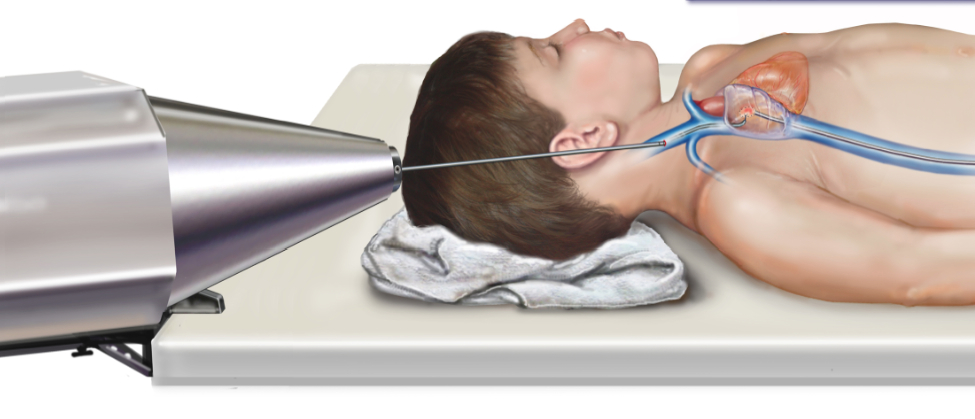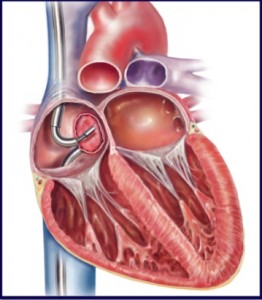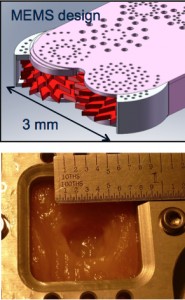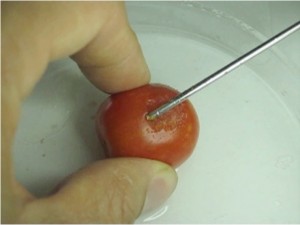Inventors and engineers tend to come up with ideas and technologies first, then say, “This is cool, what’s it good for?” Clinicians tend to say, “Here’s my clinical problem, how can I solve it?”
This was roughly the thinking that brought together Boston University engineer Pierre Dupont and Pedro del Nido, chief of Cardiac Surgery at Children’s Hospital Boston.
Dupont had a vision for a next-generation surgical robot. del Nido had a vision of doing complex cardiac repairs in children while their hearts are still beating. Could they create a viable technology?
Currently, there are two alternatives for fixing hearts. One is open-heart surgery: stop the heart, put the child on cardiopulmonary bypass, open the chest, and make the surgical repair. But there’s risk – disruption of heart rhythm, infection, dangerous air bubbles slipping into the bloodstream, and possible inflammatory responses when the blood contacts the heart-lung machine. Recovery takes weeks to months.
There’s also catheterization, a technique Children’s cardiologists have helped perfect. A narrow, flexible catheter is guided through a blood vessel to the heart, where it can remove a blood clot, inflate a small balloon to prop open narrowed structures, open up umbrella-like devices to patch holes, apply heat or extreme cold to destroy abnormal tissue, and implant devices like stents and even artificial heart valves.
But many of the things surgeons do require the application of force – to pierce and pull tissue, press tissues together, sew sutures in tight spaces – things that a noodle-like catheter isn’t designed to do.
del Nido wanted to combine surgical dexterity with the minimally invasive nature of cardiac catheterization. He enlisted the help of Dupont, who moved his lab to Children’s to become chief of Pediatric Cardiac Bioengineering. Together, they’re reinventing how heart surgery is done.
With funding from an NIH Bioengineering Partnership, they’re developing completely new, miniaturized tools to replace the surgeon’s scalpel, needle and suture, and a robotic system that could snake its way through the heart to operate these tools.
“Currently, robotic surgery involves taking existing clinical procedures and simply inserting a robot between the clinician and the patient,” Dupont said this week at the monthly Innovators’ Forum hosted by Children’s Innovation Acceleration Program. “The next generation of surgical robots should enable procedures that are currently impossible.”
The surgical robot, invented by Dupont and one of his graduate students, is small enough to use at the bedside. It has telescoping, curved, steerable “arms,” that can negotiate around delicate heart structures and approach tissue from a variety of angles.
To develop the tools, Dupont and del Nido partnered with California startup Microfabrica, Inc., which specializes in a unique process for manufacturing millimeter-scale tools from metals. The technology allows them to fabricate simultaneously large numbers of tiny, fully-assembled devices with intricate working parts. At the time, Microfabrica was looking for new applications; now, medical devices are a major thrust of the company.
The collaboration has designed and tested several new tools (best appreciated under magnification). One is a “suture substitute,” designed to close holes or join tissues. Resembling a tiny wall-anchor, its eight moving parts include adjustable wings and a ratcheting device for customized tightening. There are also tissue removal devices – a rotary razor-type device that shaves off a surface layer, and another that can mill a cavity in tissue (shown at TEDMED last fall on a grape tomato and chicken breast, respectively).
But can this technology be commercialized? Although del Nido sees applications in pediatric beating-heart surgery – reconstructing defective heart valves, for example – the market is relatively small. He and Dupont need a much larger market to entice industry to develop the technology and see it through clinical trials and FDA approval.
Physicians in the audience discussed possible uses in neurosurgery – could the tools be made from something other than metal, so they’re MRI-compatible? They could. What about fetal surgery? Maybe the robot could help improve on the operation for spina bifida, reported last week in the New England Journal of Medicine.
“When you open the uterus, you create a risk of premature birth,” said neurosurgeon Joe Madsen. “If you could do this through an amniocentesis-type device, you could make surgery much faster and much less morbid. There’d be a market for every single case of spina bifida.”
del Nido thinks the uses could be very broad. “This device provides a mechanism for doing what the surgeon does in an open procedure,” he says. “It could enable physicians to perform tissue reconstruction operations without having to open a cavity surgically, whether that be the chest, abdomen, or the brain.”
Ultimately, it may take high-volume applications in adult surgery to get investors to put their dollar down – enabling del Nido to offer beating-heart surgery to infants with complex congenital heart defects. Any ideas? Vector is ready to forward them.












